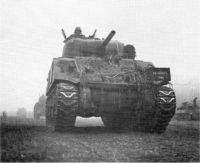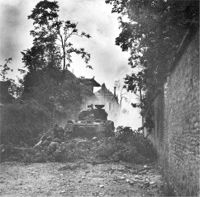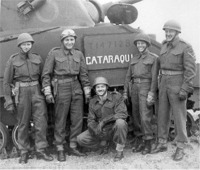 |
| Tank and Plaque commemorating the First Hussars on Juno Beach, Tillsonburg Military History Club |
I don't want to get too much into a history of the First Hussars Regiment because I hope to do a full-length one in the future, but I'll just begin by saying that it was based in London and was formed from a highly decorated Cavalry militia troop dating back to 1835.
The First Hussars were the first Non-Permanent Militia unit to be mobilized upon the outbreak of the Second World War, moving overseas as part of the 5th Canadian Armored Division in 1941, and continued training until D-Day. The Juno Beach website describes the Regiment's experience on June 6, 1944:
"The 1st Hussars Regiment was from London, Ontario. The 1st Hussars were equipped with DD (Duplex Drive) tanks. The tankers of the Hussars supported the Regina Rifles at Courseulles, the Winnipeg Rifles at Graye-sur-Mer and the Canadian Scottish on the right.
'B' squadron supporting the Reginas, landed at Courseulles at 0755 hours with 14 out of the 19 tanks remaining. The DD tanks engaged the German guns from a distance of 200 yards. An 88mm beside the harbour exit and a 50 mm behind it fired continuously until their protective shields were pierced by shells. A 75 mm on the right flank fired 200 rounds before it was knocked out. No tanks were lost in the spirited duel. When the Regina Rifles landed, they fought their way into Courseulles, and once beyond the town the tank squadrons reunited with their affiliated infantry battalions and worked their way inland against machine-gun nests and entrenched infantry.
 Seven 'A' squadron tanks landed a few minutes after the Winnipeg Rifles, on the beach west of Courseulles where the German defences included three blockhouses and more than thirteen concrete gun emplacements. The tanks fired on the 50 mm anti-tank gun emplacements. Five more tanks were landed by a LCT that earlier had had problems with its ramp. As soon as the anti-tank guns on the beach had been destroyed, the DD tanks began to cruise up and down the beach engaging the machine gun nests permitting the infantry to sweep over the dunes to begin their push inland. There were delays in creating beach exits, but the engineers were able to clear a path and complete a causeway at 0920 hours and 'A' squadron began to move toward their first objective, Graye-sur-Mer.
Seven 'A' squadron tanks landed a few minutes after the Winnipeg Rifles, on the beach west of Courseulles where the German defences included three blockhouses and more than thirteen concrete gun emplacements. The tanks fired on the 50 mm anti-tank gun emplacements. Five more tanks were landed by a LCT that earlier had had problems with its ramp. As soon as the anti-tank guns on the beach had been destroyed, the DD tanks began to cruise up and down the beach engaging the machine gun nests permitting the infantry to sweep over the dunes to begin their push inland. There were delays in creating beach exits, but the engineers were able to clear a path and complete a causeway at 0920 hours and 'A' squadron began to move toward their first objective, Graye-sur-Mer.The regimental history gives the following description: "D-Day Operation Overlord. At 0730 hours 6th June, 1944, the 6th Canadian Armoured Regiment (1st Hussars) in support of the 7th Canadian Infantry Brigade of the 3rd Canadian Division assaulted and overpowered the Hun's beach defences between Courseulles-sur-Mer and Bernières-sur-Mer and after wiping out enemy resistance moved inland…. During the rest of day the Shermans scurried here and there as the Winnipeg Rifles pressed inland and gave fire support to neutralize enemy positions. Whenever the 'Pegs' were pinned down the tanks played a role in helping the infantry to clear each successive town as the advance moved on."
 'B' squadron, reduced to half-strength and numbering only nine tanks, was severely hit when hurrying to the aid of infantry attacking Pierrepont. Five tanks were lost to fire from a well handled 88mm gun. Sgt Leo Gariepy: "I saw Lieutenant McLeod's tank burst high in flame. The troop corporal's tank suffered the same fate, and I saw several other tanks knocked out." Gariepy saw the muzzle on an 88mm gun rising from a hidden emplacement 30 yards ahead, the barrel pointing directly at him. "I gave rapid evasive orders to my driver and told my gunner to blast him. He fired two rounds; the second scoring a direct hit. I moved up to the gun emplacement and shot all the crew of 14 cowering in the trench."
'B' squadron, reduced to half-strength and numbering only nine tanks, was severely hit when hurrying to the aid of infantry attacking Pierrepont. Five tanks were lost to fire from a well handled 88mm gun. Sgt Leo Gariepy: "I saw Lieutenant McLeod's tank burst high in flame. The troop corporal's tank suffered the same fate, and I saw several other tanks knocked out." Gariepy saw the muzzle on an 88mm gun rising from a hidden emplacement 30 yards ahead, the barrel pointing directly at him. "I gave rapid evasive orders to my driver and told my gunner to blast him. He fired two rounds; the second scoring a direct hit. I moved up to the gun emplacement and shot all the crew of 14 cowering in the trench." After helping the Winnipeg Rifles through Creully, one troop of 'C' Squadron commanded by Lt. W.F. McCormick pushed on towards the objective and made it all the way to the north edge of Secqueville-en-Bessin without encountering any opposition. The troop had probably got closer to the final objective than any other element of the Allies' seaborne assault forces, but finding themselves isolated without infantry or anti-tank support they retraced their steps and rejoined the regiment.
After helping the Winnipeg Rifles through Creully, one troop of 'C' Squadron commanded by Lt. W.F. McCormick pushed on towards the objective and made it all the way to the north edge of Secqueville-en-Bessin without encountering any opposition. The troop had probably got closer to the final objective than any other element of the Allies' seaborne assault forces, but finding themselves isolated without infantry or anti-tank support they retraced their steps and rejoined the regiment.The regimental history: "In view of the losses in DD tanks due to the unsuitable weather, the First Hussars ended D-Day with a considerably smaller number of tanks than was desirable for their first night in Europe. In addition, the infantry continually had to anticipate Jerry counter-attacking heavily with armour in an attempt to kick them back on the beaches. However, the eventual appearance of the tanks with their capability of needling out the MG posts raised the morale of the infantry, so that by nightfall Harry Foster's 7th Brigade was firmly astride the line running through Fontaine-Henri, Pierrepont and St. Gabriel."
After dark the First Hussars tanks rallied in a harbour on high ground south-west of Pierrepont." (www.junobeach.info/juno4-8.htm)
 |
| Elgin County Archives |
Ultimately, tanks of the First Hussars were the only ones to reach their D-Day objectives during that fateful operation (Phil Egan, The Sarnia Journal, Nov. 10, 2016). Following their Normandy landing, they went on to take part in the brutal fighting in the bridgehead, the closing of the Falaise Gap, and the clearing of the cross channel guns at Calais. "They fought with distinction through Belgium and Holland and ended the war in Germany. During this period, the First Hussars won 72 Decorations, Certificates, or Mentioned in Dispatches, more than any other unit in the 1st Canadian Army, and were awarded 20 Battle Honours for outstanding Bravery." (1st Hussars Cavalry Fund)
"William Reed, sitting near the “Holy Roller” tank that had once rumbled up the beaches of Normandy, wiped his eyes and remembered.
Nearer to the moment than most of the 200 people in the crowd as part of a D-Day remembrance reunion, Reed had been in that same tank as a 21-year-old gunner when his crew landed on Juno Beach.
They were Reed, Frank White, Frank Fowler (who came up the name “Holy Roller”), Terry Doherty and Everett Smith — five men among thousands of Allied forces to take part in a turning-point battle of the war.
“I was almost in tears last night,” reliving those days and his comrades, said the 91-year-old who made the trip to London from his home in Fort Erie.
He was one of four D-Day veterans to attend Sunday’s remembrance event in London’s Victoria Park.
There, the Holy Roller, a permanently mounted Sherman tank, stands tribute to the Canadian war effort and to the 700 men of the First Hussars regiment.
The tank is believed to be the only one that made it all the way from D-Day through France, Belgium and Holland into Germany.
Reed served during every year of the war. But he laughs off notions that he was a war hero.
“My biggest achievement was staying alive,” he said. “I did what my dad said: ‘Don’t volunteer for anything and keep your head down.’ ”
Derek Ruttan, The London Free Press, Sunday, June 1, 2014
In addition to the "Holy Roller" in London, "Calamity," another First Hussars tank, is on permanent display outside the Sarnia Legion (Royal Canadian Legion Branch 62), and "Bold" remains stationed in Normandy (seen in title). These powerful machines, now silenced, stand as moving tributes to the men who served on them that fateful day in June 1944 and throughout the Second World War. May we never forget for a second how lucky we are that they did.
Thanks for reading,
Delany (@DLeitchHistory on Twitter)


No comments:
Post a Comment